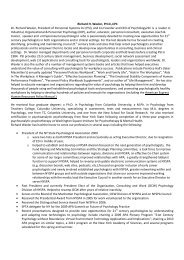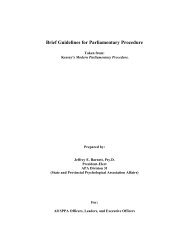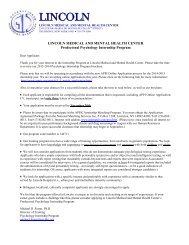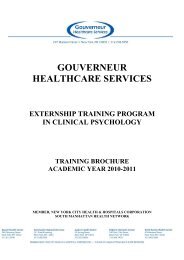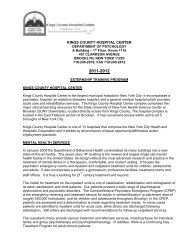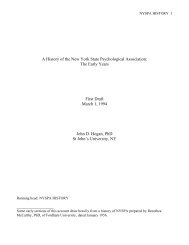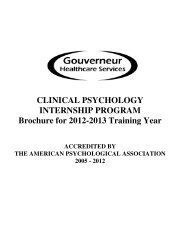2011 ⢠NYS Psychologist - New York State Psychological Association
2011 ⢠NYS Psychologist - New York State Psychological Association
2011 ⢠NYS Psychologist - New York State Psychological Association
You also want an ePaper? Increase the reach of your titles
YUMPU automatically turns print PDFs into web optimized ePapers that Google loves.
can be heard, and to help shape policy related to IPV, sexual assault<br />
and other gender related matters throughout CUNY.<br />
Creating a Methodology for Addressing IPV on Campus:<br />
Recommendations<br />
The emotional and psychological effects of relationship violence<br />
can be pervasive and longstanding. For students experiencing<br />
such abuse, their academic futures may be in jeopardy. For<br />
this reason, it is imperative for college campuses to be proactive<br />
in their efforts to address intimate partner violence. A campuswide<br />
coordinated response is needed to address IPV and to educate<br />
the campus community of its inherent dangers. Any such<br />
model should be designed to: 1) educate the college community<br />
about the nature and scope of intimate partner violence; 2) offer<br />
training to key personnel (e.g. counseling, health service providers,<br />
public safety, academic advisors) to respond to student complaints<br />
of IPV; 3) provide campus-based support services to students<br />
in need; and 4) to establish clear standards and a unified,<br />
campus-wide protocol to address IPV that will be put into effect<br />
and enforced.<br />
Educating Students, Educators, Student Support Personnel<br />
and Administrators<br />
In order to prevent occurrences of partner violence, students<br />
need to be aware of what constitutes abusive and coercive behaviors<br />
in relationships and the specific norms of racially and culturally<br />
diverse groups that promote or sanction gender violence. In<br />
order to foster this type of learning, counseling and student affairs/<br />
student support personnel may want to promote a “healthy relationship<br />
campaign” that provides clear definitions and culturally<br />
sensitive examples of the elements of productive relationships<br />
and those of corrosive relationships. Using forums such as new<br />
student orientations, freshmen seminars, and encouraging student<br />
programming among diverse student groups, fraternities,<br />
sororities and clubs is a good start. Such activities should specifically<br />
highlight national statistics of IPV so that students can understand<br />
that they are not alone; identify cultural definitions of intimate<br />
partner violence, noting how they are colored and shaped by<br />
personal experiences, familial background, and racial/ethnic heritage;<br />
explore how cultural pressures to conform to gender role<br />
expectations create opportunities for abuse; and clearly describe<br />
the signs of an abusive personality.<br />
College faculty, staff and administrators, like students, are<br />
frequently unaware of the problem of intimate partner violence.<br />
As such, professional development, faculty support and support<br />
staff training should be made available to educate all members of<br />
the college community. Colleges should develop task forces to<br />
study the problem of IPV on campus and make use of Women’s<br />
Centers that can provide training, workshops and presentations<br />
on issues of partner abuse. Specialized training should be made<br />
available to counseling professionals in learning to identify the<br />
presence of intimate partner violence and treating student victims.<br />
Male students should be actively encouraged to act as allies to<br />
support the eradication of violence against women through their<br />
participation in men’s organizations or other student groups that<br />
encourage advocacy and activism. Faculty too should become<br />
involved and encourage their students’ participation in workshops,<br />
campus-wide presentations, and town-hall summits that address<br />
partner violence. Faculty can bring their classes to such events<br />
and create class assignments attached to them. Encouraging<br />
students to write about and research what they have learned at<br />
such forums can be invaluable. As part of routine health screenings<br />
at college health centers, health center personnel should ask<br />
about the presence of partner violence (just as one would about<br />
alcohol or drug use). Student volunteerism at women’s shelters<br />
should be encouraged so that students may learn, first hand, the<br />
impact of partner and family violence. Finally, academic administrators<br />
should be encouraged to look at the problem of IPV as a<br />
possible cause for student attrition and develop research strategies<br />
to examine the relationship between partner/family violence<br />
and student retention.<br />
Conclusion<br />
Academia, still considered an ivory tower, is not immune to<br />
societal problems. Violence perpetrated against women can be<br />
found on many college campuses. Commuter college students<br />
who experience partner violence at home bring these real world<br />
problems with them into the classroom. Similarly, students living<br />
on campus bring personal lifestyle choices and behaviors into<br />
their new living quarters. Academia cannot afford to ignore these<br />
substantial issues that have every possibility of impacting their<br />
students. Moreover, as colleges become more and more culturally<br />
diverse, our students will bring with them norms from their cultures<br />
and societies that may denigrate women by our standards,<br />
and encourage abusive behaviors. Women students are being<br />
raped, stalked, threatened and violated in a variety of ways, in<br />
their homes and in their relationships. As they attempt to develop<br />
newly defined roles, they risk being confronted with negative responses<br />
to their efforts. Husbands, boyfriends, and lovers who<br />
resent their partner’s efforts toward autonomy and movement<br />
from culturally defined roles may feel incited to violence in order to<br />
restore the order and balance of power in the relationship. Thus,<br />
college counselors, mental health practitioners, and other health<br />
care professionals can take a lead role in addressing a public<br />
health concern and enhancing the experiences of all of our students.<br />
Unless we take an active role in creating policies and procedures<br />
to help students manage these experiences in their lives<br />
and help to cultivate a level of understanding of what constitutes<br />
healthy and appropriate relationships, we will continue to fail<br />
where it matters – in the creation of a civil, peaceful and respectful<br />
society.<br />
REFERENCES:<br />
American College Health <strong>Association</strong> (2005). Campus Violence White Paper.<br />
Baltimore, MD: American College Health <strong>Association</strong>.<br />
Belknap, J. & Erez, E. (2005). The victimization of women on college campuses.<br />
In B.S. Fisher & J.J. Sloan (Eds.) Campus crimes: Legal and<br />
social policy perspectives, 156-178. Springfield, IL: Charles C. Thomas.<br />
Carr, J. L. & Ward, R. L (2006). ACHA campus violence white paper. Journal<br />
of Student Affairs, Research and Practice, 43(3), 380 - 409.<br />
Catalano, S, Smith, E. , Snyder, H., & Rand, M. (2009). Female Victims of<br />
Violence. Washington, DC: U.S. Department of Justice.<br />
CUNY <strong>New</strong>swire (2010) CUNY Board approves new policy to protect and<br />
help sexual assault victims. Retrieved from http://www1.cuny.edu/mu/<br />
forum/2010/07/20/cuny-board-approves-new-policy-to-protect-and-help<br />
-sexual-assault-victims/<br />
Feminist Majority Foundation (2005) Violence against women on college<br />
campuses. Retrieved from http://feministcampus.org/fmla/printablematerials/v-day05/Violence_Against_Women.pdf<br />
<strong>New</strong> <strong>York</strong> City Department of Health and Mental Hygiene (2008). Intimate<br />
partner violence against women in <strong>New</strong> <strong>York</strong> City. <strong>New</strong> <strong>York</strong>: <strong>New</strong><br />
<strong>York</strong> City Department of Health and Mental Hygiene.<br />
<strong>New</strong> <strong>York</strong> <strong>State</strong> (2008). Domestic Violence Dashboard project: 2008 data.<br />
Retrieved from http://www.opdv.state.ny.us/statistics/nydata/2010/<br />
nys2010data.pdf<br />
Rennison, C. M. (2003). Intimate partner violence, 1993-2001. Washington,<br />
DC: U.S. Department of Justice, Bureau of Justice Statistics.<br />
Tjaden, P. & Thoennes, N. (2000). Extent, nature and consequences of<br />
intimate partner violence: Findings from the National Violence against<br />
Women Survey. Washington, DC: National Institutes of Justice.<br />
U.S. Department of Justice, Bureau of Justice Statistics (2009, September).<br />
Female victims of violence. Washington, DC: U.S. Department of Justice.<br />
U.S. Department of Justice, Bureau of Justice Statistics (2003, February).<br />
Intimate partner violence, 1993-2001. Washington, DC: U.S. Depart-<br />
Page 27<br />
Vol. XXIII No. 2 • Fall <strong>2011</strong> • <strong>NYS</strong> <strong>Psychologist</strong>



